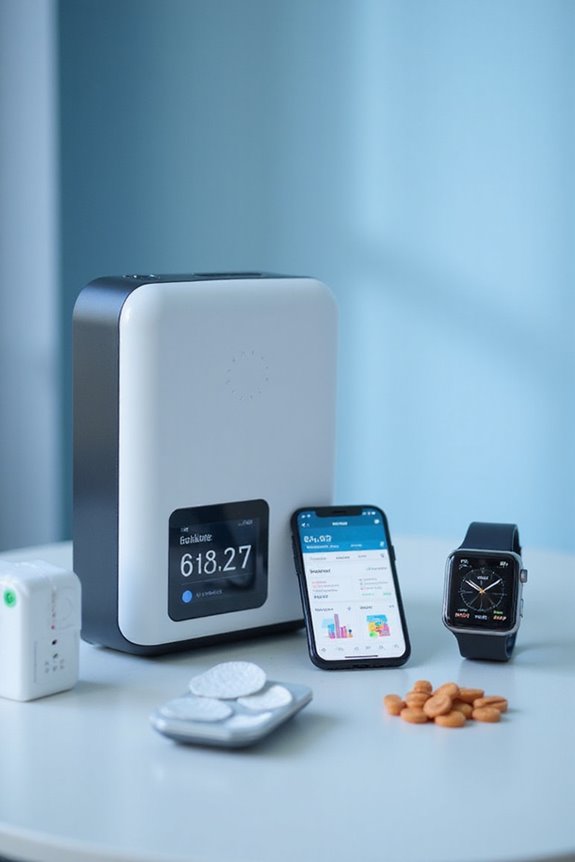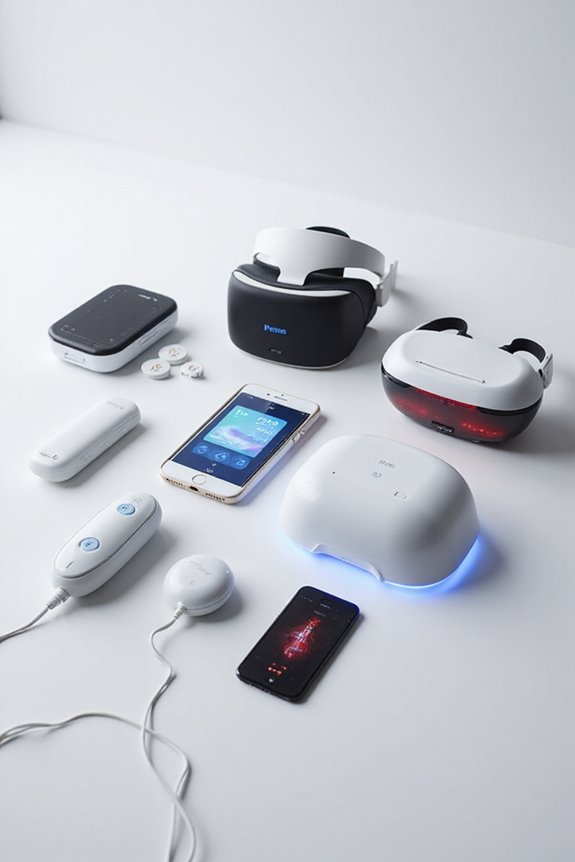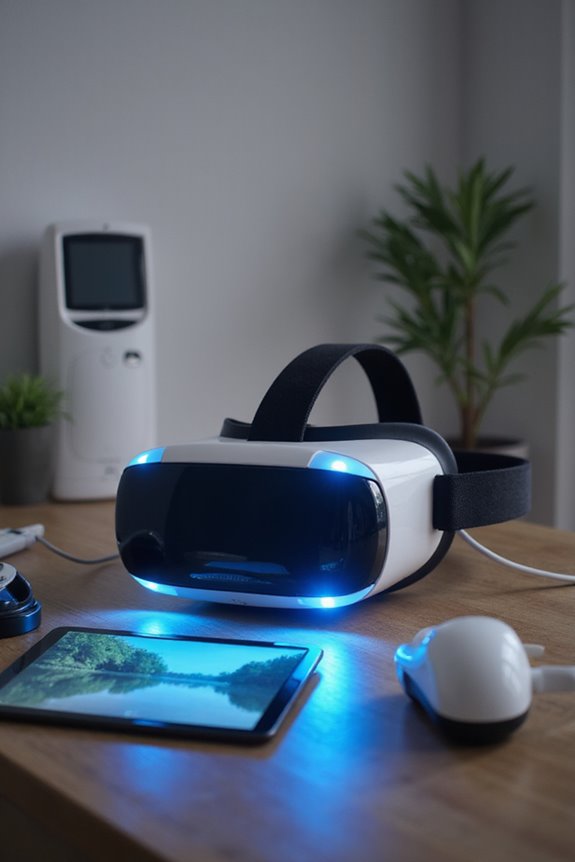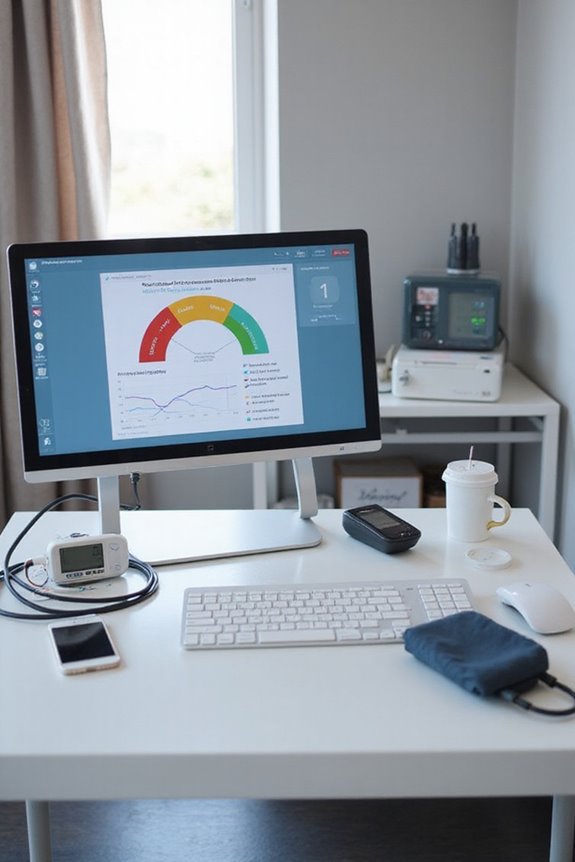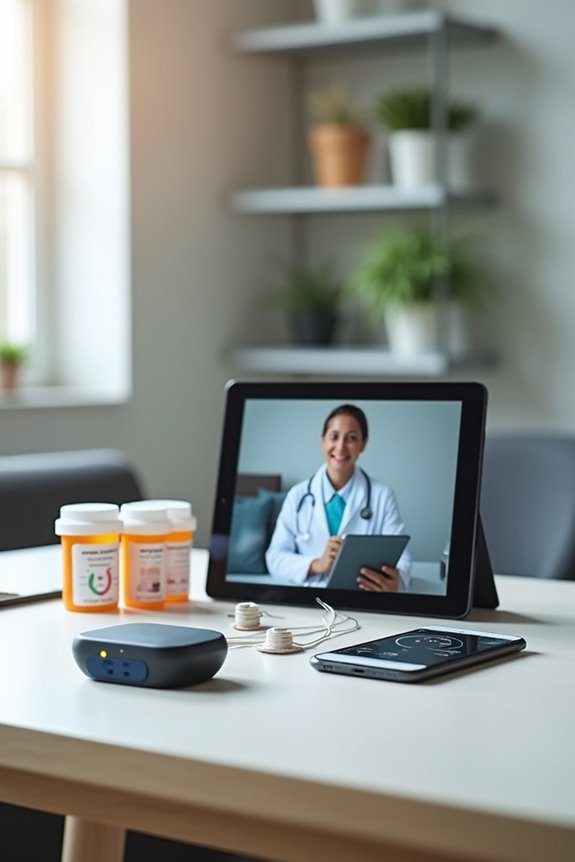Technology has the potential to greatly enhance pain medication adherence. Innovative solutions, including mobile apps and wearable devices, facilitate tracking and monitoring of medication intake. Studies reveal that electronic tools can improve prescription pickup by 19% and reduce therapy initiation time by 34%. Despite barriers such as technical complexity, user interface challenges, and economic constraints, digital solutions offer real-time data collection and personalized engagement. Further exploration offers insights into advancements in adherence-enhancing technologies.
Key Takeaways
- Mobile apps and wearable devices track medication intake and pain levels, enhancing patient engagement and adherence to pain management plans.
- Electronic tools like ePA and RTPB reduce cost barriers and delays, increasing access to medications and improving adherence rates.
- Ingestible sensors and MEMS provide accurate real-time monitoring of medication ingestion, ensuring better compliance and adherence tracking.
- AI-driven analytics offer personalized treatment plans and timely interventions, tailoring care to individual patient needs and improving adherence outcomes.
- User-friendly interfaces and engaging patient tools, such as chatbots, help overcome barriers and promote consistent medication adherence in chronic pain management.
The Importance of Medication Adherence in Pain Management
Medication adherence is a crucial component of effective pain management, particularly for patients suffering from chronic pain conditions. Nonadherence rates among these patients average around 40%, with serious consequences including undertreated pain and increased healthcare costs.
Key Statistics:
- 57% of elderly patients self-report medication nonadherence.
- Nonadherence can lead to opioid dependence and diminished quality of life.
Factors Influencing Adherence:
- High dosing frequency and multiple medications are associated with nonadherence.
- Patient beliefs about medication, such as fear of addiction, impact adherence negatively.
Adherence Strategies:
- Enhanced patient education is essential for improving adherence.
- Building trust in patient-caregiver relationships can facilitate better communication and adherence.
Addressing these factors is essential for optimizing pain management outcomes.
Innovative Technology Types for Enhanced Adherence
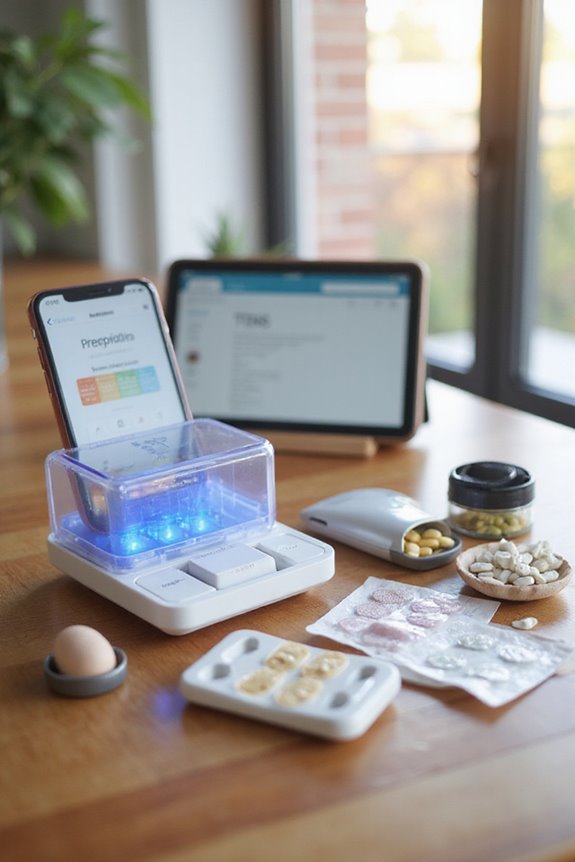
Innovative technologies have emerged as essential tools in enhancing medication adherence for patients managing chronic pain. Among these, mobile apps and wearable devices play a vital role.
Mobile Apps:
- Enable daily tracking of pain levels and medication intake.
- Facilitate identification of pain triggers through pattern recognition.
- Provide educational content on pain management techniques.
- Include reminder features to support punctual medication adherence.
Wearable Devices:
- Monitor physiological signals related to pain in real time.
- Use biosensors to verify ingestion and track adherence.
- Transmit adherence data wirelessly for continuous oversight.
- Offer customizable alerts for missed doses, boosting compliance.
These technologies not only empower individuals to manage their pain effectively but also enhance communication with healthcare providers, fostering a supportive treatment environment.
Impact of Technology on Patient Compliance Rates
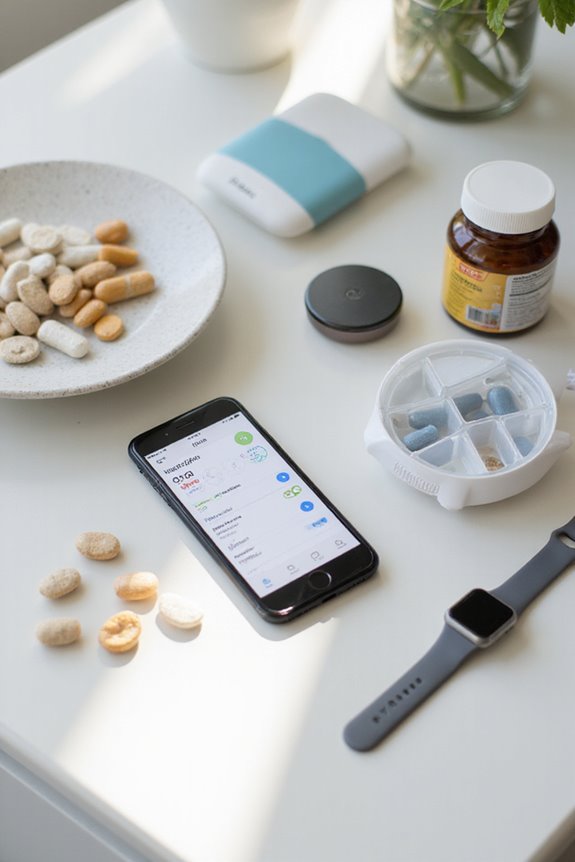
The integration of technology into healthcare has considerably influenced patient compliance rates, particularly in medication adherence. Notable advancements include:
- Electronic Prior Authorization (ePA) and Real-Time Prescription Benefit (RTPB) tools, which reduce cost barriers and delays, resulting in a 19% increase in medication pickup.
- Specialty dashboards and hub services accelerate therapy initiation, leading to a 34% reduction in time to therapy.
- Enhanced visibility into patient medication access lowers prescription abandonment.
Despite these advancements, challenges remain in patient monitoring. Traditional adherence metrics, such as self-reporting and pill counts, often lack accuracy. Emerging technologies, including Medication Event Monitoring Systems (MEMS), aim to address these issues, facilitating better adherence data and enabling informed interventions through effective technology integration.
Key Features of Medication Adherence Technologies

Advancements in medication adherence technologies encompass a variety of features designed to enhance patient compliance and improve healthcare outcomes. Key features include:
- Smart Pillboxes: Equipped with sensors, these devices provide alerts via smartphone for timely medication intake, ensuring consistency in dosing.
- Wearable Reminders: These devices offer continuous monitoring and real-time feedback, employing audio or vibration alerts to notify patients of medication times.
- Automated Dispensing Units: These systems release the correct dosage at prescribed intervals, preventing overdose or underdose scenarios.
- Mobile Applications: Apps allow for personalized reminders, medication tracking, and direct communication with healthcare providers, facilitating better management.
- Data Integration: Real-time adherence data is transferred to healthcare providers, enabling timely treatment adjustments and improving patient safety.
Barriers to Effective Use of Technology in Adherence

Despite the potential benefits of technology in enhancing medication adherence, several barriers impede its effective use.
Complexity of Current Solutions
- Many systems require technical expertise, leading to user frustration.
- Lack of user-friendly interfaces hampers adoption, impacting user experience.
Technological Limitations
- Data accuracy issues arise from unreliable sensors and reminders.
- Integration challenges with existing healthcare systems hinder effectiveness.
Cost and Accessibility Barriers
- Economic constraints limit access for low-income patients.
- Internet connectivity issues further exacerbate disparities in technology use.
User Engagement and Behavior
- Forgetfulness and lack of motivation can diminish engagement.
- Resistance to change from traditional methods affects technological trust.
Integration and Standardization Challenges
- Difficulty in standardizing data formats complicates interoperability among systems.
- Evolving regulatory frameworks add to the complexity.
Advantages of Data Collection Through Digital Solutions
Data collection through digital solutions offers significant advantages in enhancing medication adherence.
- Improved Accuracy: Passive measurement methods, such as smart packaging, guarantee precise recording of dosing events.
- Real-time Data: These solutions enable immediate observations of patient behaviors, facilitating timely interventions.
- Automatic Data Collection: Digital tools minimize the reliance on patient input, leading to more dependable data.
- Enhanced Patient Engagement: Personalized feedback through digital platforms strengthens the patient-provider relationship.
- Cost-Effectiveness: Digital studies are typically quicker and less expensive than traditional methods, proving to be a valuable option.
The Role of Patient Engagement in Utilizing Technology
Patient engagement plays a critical role in the effective utilization of technology for medication adherence. By fostering ongoing communication between patients and providers, digital tools enhance patient empowerment and support adherence strategies. Key statistics highlight this relationship:
- Digital engagement contributes to over $100 billion in preventable medical costs annually due to medication nonadherence.
- E-prescribing systems show a 10% increase in first-fill adherence, demonstrating early commitment to treatment.
- Approximately 89% of studies indicate a positive impact of information technology on patient behavior.
Effective communication strategies, through automated reminders and tailored health information, reduce forgetfulness and misunderstandings. Ultimately, patient engagement technologies not only facilitate adherence but also promote better health outcomes, making them essential in modern healthcare.
Case Studies: Successful Implementation of Adherence Technologies
The implementation of technology to enhance medication adherence is evidenced by various successful case studies across the healthcare landscape.
AARDEX Group’s Technology
- Assisted Iroko Pharmaceuticals by providing reliable adherence data for FDA approval.
- Accurately tracked patient medication behavior, demonstrating compliance and treatment efficacy.
Carenet Health’s Outreach
- Achieved 106% of enrollment goals through a retail-to-mail pharmacy program.
- Personalized interventions improved member engagement and adherence outcomes.
Smart Pill Bottles
- Companies like AdhereTech developed bottles that track adherence data and send alerts.
- These tools enhance communication and responsiveness in specialty pharmacy management.
Ingestible Sensors
- Proteus Digital Health’s system combines ingestible pills and wearable patches for accurate adherence monitoring.
- This technology shows potential for broader patient applications in daily medication adherence.
Future Directions for Technology in Pain Medication Adherence
As advancements in technology reshape healthcare, the future of pain medication adherence is poised for significant transformation.
Enhanced Predictive Analytics
– AI algorithms will enable accurate risk prediction for timely interventions, improving patient outcomes.
Personalized Treatment Plans
– Future technology will analyze extensive patient data, creating individualized care plans that enhance adherence.
Patient Engagement Tools
– AI-driven chatbots and health coaches will empower patients, improving their experiences in chronic pain management.
Digital Pill Technology
– Ingestible sensors will monitor medication adherence, addressing compliance issues effectively.
Real-time Monitoring
– AI will facilitate real-time patient health monitoring, allowing for prompt interventions when adherence challenges arise.
The integration of these technologies aims to enhance patient experiences and reduce healthcare costs through improved treatment effectiveness.
Frequently Asked Questions
How Do Wearable Devices Improve Pain Medication Adherence?
Wearable devices enhance pain medication adherence by providing real-time tracking accuracy, reminding users of their medication schedules. These wearable benefits foster a sense of accountability and support, ultimately promoting healthier habits among individuals managing chronic pain conditions.
Are Mobile Apps Secure for Tracking Medication Adherence Data?
In a digital age where data privacy feels precarious, mobile apps for medication adherence can offer secure tracking, provided user authentication safeguards are robust. Trust hinges on transparency, ensuring users feel valued and protected in their health journeys.
What Costs Are Associated With Adherence Technology?
Cost evaluation of adherence technology reveals significant upfront technology investment, including software and hardware, alongside potential ongoing expenses for integration and patient engagement initiatives, ultimately impacting overall healthcare cost savings and patient outcomes.
How Can Patients Build Digital Literacy for Medication Apps?
To build digital literacy for medication apps, patients can enhance their digital skills through structured tutorials and peer workshops, focusing on app navigation, which fosters confidence and encourages a sense of community among users.
Can Adherence Technologies Replace Regular Doctor Appointments?
Statistics reveal that over 80% of patients miss appointments annually. While telehealth consultations and remote monitoring enhance flexibility, they cannot fully replace the personalized care and support essential for managing complex pain conditions effectively.

